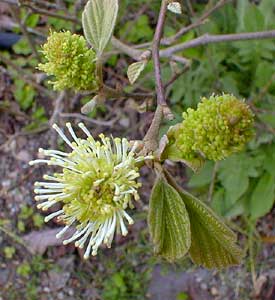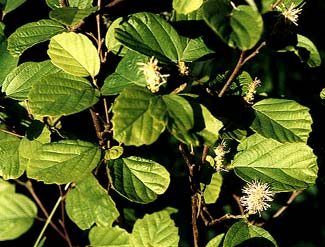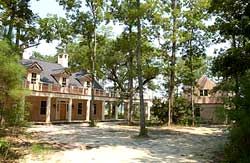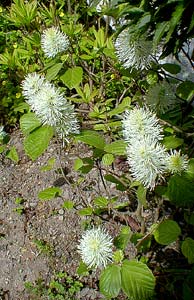 Mount Airy
Mount Airy
Bottlebrush,
Fothergilla,
or Witch Alder
Mount Airy Fothergilla is a hybrid of Fothergilla gardenii (Dwarf Witch Fothergilla, which grows 3 to 5 feet) & F. major (Large or Mountain Fothergilla, 8 to 12 feet), resulting in an intermediate-sized 4 to 8 foot shrub.
The fothergillas are named for Quaker physician John Fothergill (1733-1814), a physician & gardener in 18th Century London. He funded the travels of William Bartram resulting in the 1791 classic Travels Through North & South Carolina, Georgia, East & West Florida. You can read a little about Bartram alongside his portrait on the page about Jacob Kline's Bee Balm, & you may also get a kick out of the article about Dr. Fothergill, Occult Physician & Patron to Botanists.
 The species name gardenii is in honor of Dr. Alexander Garden (1730-1791), who was among John Fothergill's many correspondents. The wonderfully named Dr. Garden was a Scottish physician & botanist who from 1752 to 1776 lived in South Carolina, where he first spied the shrub in 1765. His father, also named Alexander (1685-1756), likewise came to Charleston where he was influential as a clergyman for the Church of England, a good man who advocated for the education of black people & the abolition of slavery.
The species name gardenii is in honor of Dr. Alexander Garden (1730-1791), who was among John Fothergill's many correspondents. The wonderfully named Dr. Garden was a Scottish physician & botanist who from 1752 to 1776 lived in South Carolina, where he first spied the shrub in 1765. His father, also named Alexander (1685-1756), likewise came to Charleston where he was influential as a clergyman for the Church of England, a good man who advocated for the education of black people & the abolition of slavery.Dr. Garden's name is best immortalized by the Gardenia, so named in 1761 by John Ellis (1710?-1776). Of course the Gardenia was from Asia rather than part of the flora of the Carolinas to which Dr. Garden devoted his life, but Gardenias were grown as favorite garden shrubs in Charleston as early as 1762. Dr. Garden was forced to leave Charlestone after the Revolutionary War because he had been a Loyalist faithful to the King. He returned to England in 1782, & nine years later, Gardenias were to dominate at his London funeral.
When Dr. Garden left America, his property in Charleston was confiscated because of his Loyalist stance. But his son, again named Alexander (1757-1829), joined the Revolutionary army in 1780, served as aide-de-camp to General Greene, & was a lieutenant in Lee's legion, so that after the war was won, the family property was restored to the son in light of his service to South Carolina's cause.
 Dr. Garden's pre-Revolutionary home still stands at 18 Basilica Ave., Haughan, near Charleston, & is on the National Historical Register. This home & the garden-plantation that once stretched out around it was called Otranto, after the castle made famous by Walpole's classic gothic novel. I hope eventually to find a photo of Otranto as it survives today, but for the moment all I have is a real estate photograph of a replica of Otranto built at the Northwest tip of Goat Island.
Dr. Garden's pre-Revolutionary home still stands at 18 Basilica Ave., Haughan, near Charleston, & is on the National Historical Register. This home & the garden-plantation that once stretched out around it was called Otranto, after the castle made famous by Walpole's classic gothic novel. I hope eventually to find a photo of Otranto as it survives today, but for the moment all I have is a real estate photograph of a replica of Otranto built at the Northwest tip of Goat Island.Fothergilla has been in gardens in England as well as America for two hundred years. Witch Alders became popular in the late 1700s in England, very soon after Dr. Garden having described them.
George Washington planted them in his garden in 1792, a few years after Thomas Jefferson had specimens sent to Paris for the gardens of Madame de Tesse. After a long period of popularity, it fell out of favor in the 20th Century, but has lately regained some of its popularity, not least because of the improved qualities of the Mount Airy hybrid.
A quarter-century ago, this hybrid occurred by accident then was further developed at the the Mount Airy Arboretum in Cincinnati.
 The first photo (April 2003) shows the buds & some first blossoms as they begin to form in April. Sometimes it begins to flower ahead of the leaves as it did this year, but other times it begins to leaf then flowers. The second photo (June 2002) shows the mature leaves & some of the bottlebrush blooms. The last photo (May 2003) shows fuller bottlebrushes.
The first photo (April 2003) shows the buds & some first blossoms as they begin to form in April. Sometimes it begins to flower ahead of the leaves as it did this year, but other times it begins to leaf then flowers. The second photo (June 2002) shows the mature leaves & some of the bottlebrush blooms. The last photo (May 2003) shows fuller bottlebrushes.It has a strong upright habit, as wide as it gets tall. The leaves in spring & summer are a wonderful bluish green adding excellent texture to an array of shrubs. The foliage turns the most startling orange, red, purple & yellow in autumn, as can be seen on the Fothergilla page of the Autumn Foliage Gallery. These autumn colors are truly winning & makes "Mount Airy" a pleasing alternative to the over-utilized smokebush.
There are only three species of fothergilla & all are native of the American Southeast. Mount Airy fothergilla wants well-drained moist acid soils. It flowers best in full sun, & develops more intense autumn colors when it gets plenty of sun, though it is highy adaptable so will thrive in part shade.
Our two specimens are somewhat shaded respectively by larger shrubs, but get sufficient sun that they do achieve excellent autumn coloration in October. It is thickly flowered late April through early June, the white fluffy-looking one-inch furry balls having a scent of wild honey. The common name "Bottlebrush" is of course from the form of the bloom. It is also called Witch Alder, being a relative of Witch Hazel, & produces small witchhazel-like nuts, charming but not very noticeable.